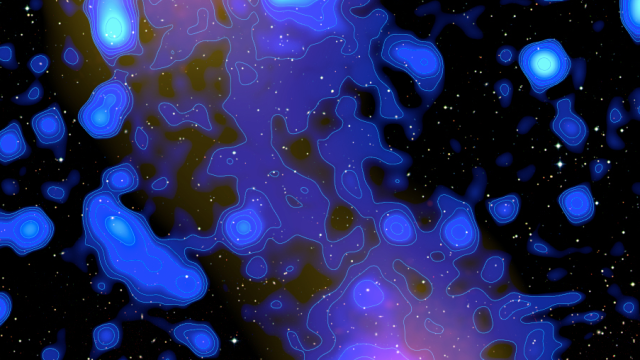Scientists have detected radio waves emanating from the space between a pair of galaxy clusters—evidence of intergalactic magnetic fields and fast-moving particles in the space between these giant galactic assemblages.
The universe is comprised of a vast network of galaxy clusters sitting at the intersection of filaments. Galactic filaments are massive, threadlike formations of matter that make up the large-scale structure of the universe. Scientists were previously aware of a filament around 10 million light-years long that links galaxy clusters Abell 0399 and 0401 and magnetic fields within the clusters, but they wondered whether this filament itself contained magnetic fields and relativistic particles (meaning particles accelerated to nearly the speed of light).
This is the first such detection of a magnetized filament, according to the study’s authors, and will hopefully help them better understand how the universe’s large-scale structure came to be.
“From a theoretical point of view, it’s really challenging to explain this radio emission,” Federica Govoni, the study’s first author from the Cagliari Observatory of Italy’s Istituto Nazionale di Astrofisica, told Gizmodo.
The researchers used the Low Frequency Array (LOFAR) telescope network, a sensitive system consisting of thousands of radio antennas across dozens of stations, mostly in the Netherlands, to hunt for low-frequency radio-wave emissions from between the galaxies. They interpret the signal as the presence of synchrotron radiation, or particles spiraling at nearly light speed due to the influence of a magnetic field.
Such a signal showed up in the data without an obvious source to cause it, according to the paper published in Science. They were able to estimate the strength of the magnetic field and even noticed hints of some substructure, or brighter features aligned in the filament’s direction. Jason Tumlinson, astronomer on the research staff at the Space Telescope Science Institute who was not involved with the study, told Gizmodo it looked like “an impressive observation.”
But here’s the mystery—the feature that the scientists detected is tens of times longer than the distance that a relativistic electron can travel in its lifetime. How were they able to measure the relativistic electron’s signature radio waves, then? The researchers suggest that an existing population of electrons has been accelerated by weak shockwaves occurring in the region, produced as the structure was being formed.
Govoni told Gizmodo that this observation, along with followup measurements, have given her confidence that what they’re seeing is real. Now, she hopes to study this radio signal in further detail and look for signals like it between other galaxy clusters to see if it’s a common phenomenon in the cosmic web.
